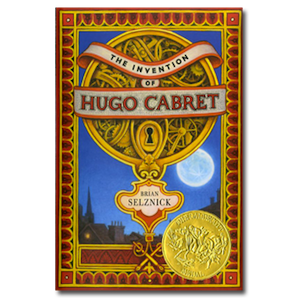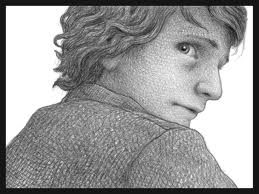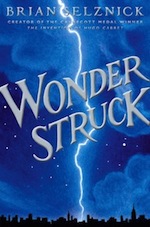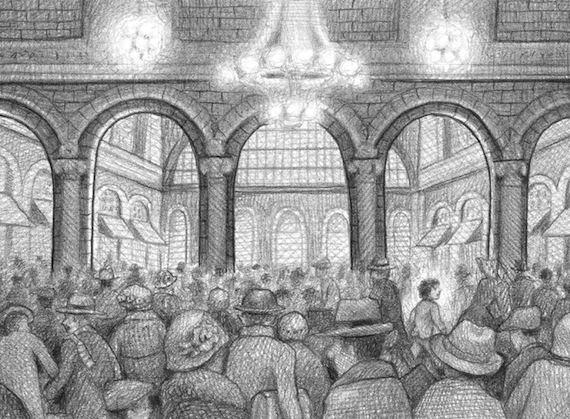How We Write Out Loud: Envisioning Hugo Cabret
A MiddleWeb Blog
 The statewide testing is over. It was mostly what I had envisioned it would be.
The statewide testing is over. It was mostly what I had envisioned it would be.
The first two days of the test involved a lot of writing, but the last three days offered me open afternoons to concentrate on developing our last writing piece of the year – a third person, realistic narrative.
The term envisioning is relatively new to my everyday vocabulary. Two years ago, envisioning was a mini-lesson in the Reading Workshop my district had just adopted.
When I envisioned how I would manage the workshop program before implementing it, the picture was blurry. Through many diverse and thought-provoking read alouds this year, however, envisioning has become a part of each day. The camera lens is tightening its focus. All I really need to do is something that I love to do anyway in my personal reading.
As I focus more cognitively on my own thoughts while reading, I notice my tendency to go back and re-read sentences that caused me pause and appreciate the beauty of the sentence and what it was trying to convey – or the irony in it – or the odd and entertaining use of figurative language. I just needed to model the same thing out loud as I read with the kids.
Then there’s writing . . .
Helping my students envision as they write is harder. Recently, though, I re-discovered a novel I wanted to share with my class, one that might help me develop as a teacher of writing. When I first picked it up and flipped through its pages – which present the narrative by blending illustrations and text – I began to visualize a way to teach kids about how writers do their work.

The kids closed their eyes as we began Professor H. Alcofrisbas’s brief introduction, which would also serve as the introduction to our work as narrative writers:
The story I am about to share with you takes place in 1931, under the roofs of Paris. Here you will meet a boy named Hugo Cabret…Follow him…His head is full of secrets, and he’s waiting for his story to begin…
The text-free pages that immediately followed were greeted with a quiet awe. Through his illustrations, Selznick offered us the opportunity to write the story that he had envisioned. It would be our job to tell it with words. (This slideshow includes exactly the pages that I used to model how to write setting and begin to develop characters.)
Writing with our mind’s eye
Our first lesson focused on setting. As I slowly turned the illustrated pages, the city of Paris emerged at sunrise.
Then we wrote. Well, technically I wrote, but I wrote out loud.
“The sun rose slowly over the beautiful city of Paris. The undisturbed quiet of the city floated in a whisper above the deserted train station. Travelers began to arrive at the old train station, hustling and bustling to find their way to their destination.”
The response was favorable, and there were a few suggestions about things I might want to add. (Evidently, the color of the sunrise and birds chirping were needed in my prose).
Then it was their turn. I asked them to choose any setting, close their eyes, and envision it. Then they needed to open their eyes, take out their Writers’ Notebooks, and describe it. The only rule?…”Nothing can happen in the story…yet.”
After about ten minutes, we stopped to share our written illustrations. The banks of the Chesapeake came alive with seagulls and sea life. A quiet alley became a dark mystery. A soccer field roared with the cheers of an enthusiastic crowd (a similar crowd was cheering in my head as I walked around reading their settings).
I did my best to give them time to share their writing. Time, an ironic theme in the story of Hugo Cabret, is a constant challenge. The clocks keep ticking too quickly in our world at school.
Imagining a character
As Selznick’s story continues, we meet Hugo, illuminated with light in the middle of a chaotic train station. I couldn’t help but point out the artist’s use of light in this illustration. Our eyes were meant to find Hugo amidst the chaos. Our first close-up of Hugo followed and gave us the opportunity to introduce and describe a main character. Hugo’s eyes, as they stare over his shoulder at us, are filled with something…
“He looks like he’s scared.”
“He wants to make sure nobody’s following him.”

“Hugo slipped through the crowd. He crossed the vast floor of the station, pushing toward the hallway that was waiting for him across the crowded terminal. He ducked into it quickly and began climbing the stairs. A quick glance behind him made him sure that nobody was watching. In his eyes, was a look of cold fear. Hugo couldn’t risk being caught. He looked back one more time, and then swiftly ran up the stairs.”
Then they opened their Writers Notebooks and began to create characters of their own.
Eager to tell a story
Later, when I asked the kids to write a complete first draft of their story, there wasn’t a single grumble (well, not one that I heard).
I set the timer for 30 minutes. The only rules: write a setting that the reader can envision and introduce the character a little before you dive into the plot.
When the timer went off at 2:30, there were groans.
“I’m not even at the climax yet!”
“Can we have a little more time?”
“Yes, you may…five more minutes.”
A different kind of time
It was a different story when the timer went off during our NJASK testing. The kids had to stop writing. I had no choice. If they begged for time then, the answer was always “No.”
The environment changed in that week after testing, though, as we finished our write-aloud. If we wanted to use the clock, we did. If not, that was fine too. We could lose ourselves in the rest of Hugo’s story.
We were back to the business of learning. It’s a much better use of time. As the minutes fly by and we rush toward the end of another school year, we’re going to make it time well spent.
Some resources

Teaching Books.net – The Invention of Hugo Cabret
Guide for Readers of Selznick’s Hugo Cabret (2007) and Wonderstruck (2011)





































I love that book, and I have a DVD of Selznick talking about how he wrote the book, pulling back the veil on the writing process. It’s great (it came with the audio CD set).
And check out the film referenced in the book: http://youtu.be/BNLZntSdyKE Pretty cool to share with students.
Kevin
We watched some of Georges movie clips after reading it, and one of the kids brought in a DVD of the movie to “compare and contrast”…and watch a movie at the end of the year!…I’m looking forward to working with the story again next year…maybe I’ll need to get that DVD you mentioned…Thanks, Kevin!